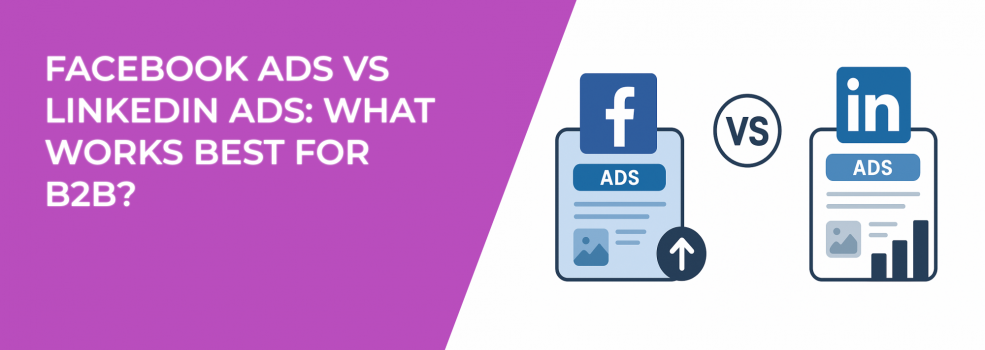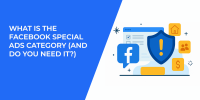When it comes to B2B advertising, two platforms dominate the conversation: Facebook and LinkedIn. Both promise precise targeting, brand visibility, and measurable results. But which one actually delivers more value for B2B marketers? The truth is — it depends on your goals, your audience, and how you structure your campaigns.
Let’s break it down.
Audience Targeting: Reach vs Relevance
Facebook offers unmatched scale. With billions of active users worldwide, you’ll find business professionals there just like you’ll find everyone else. The challenge? Separating true decision-makers from the noise. Facebook’s targeting options — job titles, interests, lookalikes, and custom audiences — make it possible, but they require careful planning and testing.
LinkedIn, on the other hand, was built for professional networking. If you want to reach CFOs at mid-sized tech companies or HR managers in healthcare, LinkedIn makes it straightforward. Its audience filters — industry, company size, job function, and seniority — let you focus directly on the people who influence or make buying decisions.
Here’s how the two stack up:
-
Facebook Targeting Strengths
-
Wide reach across industries and geographies.
-
Advanced retargeting options (website visitors, video viewers, page engagement).
-
Cost-effective way to test different audience segments.
-
Lookalike audiences that help you scale once you’ve identified a winning customer profile.
-
If you’re leaning toward Facebook, make sure your targeting is precise — this Facebook Ad Targeting 101 guide breaks down how to reach the right people without wasting budget.
-
LinkedIn Targeting Strengths
-
Precision targeting by job title, company size, and seniority.
-
Easier access to niche professionals and B2B decision-makers.
-
Stronger alignment with business intent (users are in a work mindset).
-
Built-in credibility for thought-leadership and professional content.
-
So which is better? If you’re after broad reach at a lower cost, Facebook wins. If you want hyper-relevant professional targeting with less waste, LinkedIn has the edge. Many B2B advertisers actually use both — Facebook to cast a wide net and build awareness, LinkedIn to zero in on the high-value contacts who can move deals forward.
Cost and ROI: Where Does the Money Go?
Budgets matter, especially in B2B where the sales cycle can stretch for months. Every click, impression, and lead has to prove its value over time.
Facebook ads typically cost less per click and per impression. That means you can generate traffic and capture leads at a lower entry price. It’s common to see:
-
Lower CPM (cost per thousand impressions) — making Facebook ideal for brand awareness.
-
Lower CPC (cost per click) — driving more traffic to your landing pages.
-
Affordable testing opportunities — you can experiment with different creatives and audiences without burning through budget.
Wondering if the lower cost of Facebook actually leads to real returns? Check out this breakdown on whether Facebook ads are worth it for different types of businesses.
LinkedIn ads, by contrast, almost always come at a higher price. But the trade-off is quality. You’re paying more for a smaller but more qualified audience. Here’s what that usually looks like:
-
Higher CPC — sometimes 3–5 times more than Facebook.
-
Higher CPL (cost per lead) — especially if you’re using lead gen forms.
-
Better lead-to-customer conversion rates — because you’re reaching decision-makers directly.
Think of it this way: you might pay $4 per lead on Facebook versus $20 on LinkedIn, but if LinkedIn leads close deals five times more often, the math works in its favor.
The smartest way forward? Test both platforms. Instead of focusing only on cost per click, track cost per qualified lead and cost per closed deal. Those are the numbers that truly show ROI.
Ad Formats: Engagement vs Professional Context
When it comes to ad creativity, Facebook offers a wide toolbox:
-
Video ads for storytelling and building emotional connection.
-
Carousel ads to showcase multiple products, features, or use cases.
-
Instant forms that make sign-ups frictionless.
-
Dynamic product ads that follow users across their journey.
This flexibility makes Facebook perfect for capturing attention and driving large-scale engagement. You can retarget audiences who:
-
Watched your videos,
-
Clicked your ads,
-
Visited your website,
-
Or even engaged with your Facebook page.
If you’re exploring Facebook, take time to review the ultimate guide to Facebook ad format so you can match each format to your campaign goals.
LinkedIn ads lean in a different direction — professional credibility. People scroll LinkedIn with a work mindset, so the formats are tailored for B2B intent. Some of the strongest options include:
-
Sponsored content in the feed that looks like native posts.
-
Sponsored InMail (now Message Ads) that land directly in inboxes.
-
Lead gen forms that auto-fill professional details from LinkedIn profiles.
The context matters. While Facebook excels at broad engagement, LinkedIn thrives in settings where people are already thinking about partnerships, hiring, or business growth.
Imagine this scenario: a short, engaging video case study on Facebook warms up a wide audience. Then, a week later, a LinkedIn Message Ad reaches those same people with a personalized offer or whitepaper. The platforms complement each other beautifully when used strategically.
Lead Quality and Funnel Fit
Ask yourself — what kind of leads do you need right now?
If your goal is top-of-funnel activity, Facebook will deliver. It’s designed for:
-
Building awareness among a broad professional audience.
-
Driving low-cost engagement like clicks, downloads, and sign-ups.
-
Filling remarketing pools that can be nurtured later.
But if your sales team is looking for ready-to-talk prospects, LinkedIn often outshines. That’s because you can:
-
Target by seniority (C-level, director, manager).
-
Narrow by company size or industry.
-
Filter for people with specific job functions.
This reduces wasted conversations and gives your sales reps more time with decision-makers.
A smart B2B strategy doesn’t have to choose one over the other. Here’s a practical mix many advertisers use:
-
Facebook for awareness — run cost-effective campaigns to capture broad interest and build remarketing lists.
-
Facebook retargeting — nurture prospects with case studies, testimonials, and content.
-
LinkedIn for precision — deliver highly targeted offers or meeting requests to the exact people who influence purchasing decisions.
This “broad to narrow” funnel approach gives you both volume and quality — without putting all your budget in one basket.
Which Platform Should You Choose?
There’s no one-size-fits-all answer.
-
For awareness and broad testing: Facebook is your best bet.
-
For direct access to business decision-makers: LinkedIn outperforms.
-
For a full-funnel B2B strategy: Use both, but assign different roles to each.
Instead of asking “Which is better?”, a sharper question might be: “How do I use Facebook and LinkedIn together to maximize results?”
Final Thoughts
Facebook Ads and LinkedIn Ads both work for B2B — just in different ways. Facebook gives you volume and creative flexibility at lower costs. LinkedIn gives you professional accuracy and higher-quality leads.
Marketers who succeed in B2B aren’t choosing one over the other blindly. They’re testing, measuring, and combining both platforms to cover the entire buyer’s journey.
So, before you launch your next campaign, ask yourself: do I need reach, relevance, or both? The answer will point you toward the platform — or mix of platforms — that brings the highest ROI.

